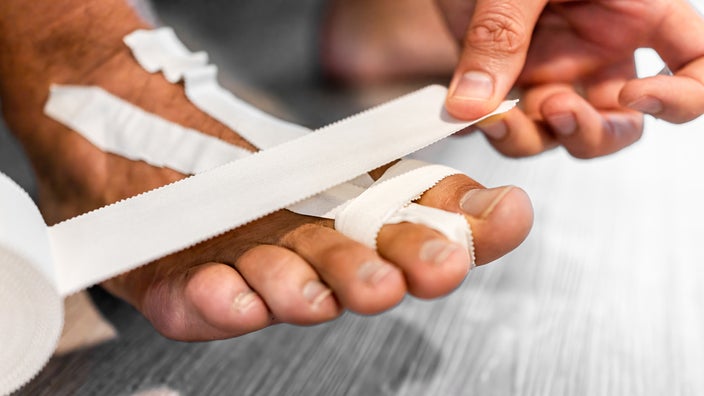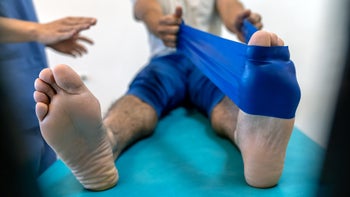
What Do You Do for a Broken Toe?
Key takeaways:
Most broken toes can be treated at home with things like rest, ice, and taping. This is especially true for a broken middle and pinky toe.
In rare cases, a broken toe might require surgery. You’re more likely to need surgery if you break your big toe.
On average, a broken toe will heal in 6 to 8 weeks.

Almost everyone has stubbed their toe or dropped something heavy on their foot. And this can easily lead to a broken toe (also called a toe fracture). The risk for injury is even higher in the summer, when sandal weather increases the chance for injury.
Most people can treat their broken toe at home. But certain types of broken toes may need a little more treatment, like surgery. There are some easy ways to know if your toe is broken, and what to do next.
What are the symptoms of a broken toe?
You might wonder what a broken toe looks like. Sometimes it’s hard to tell without an X-ray. But there’s a good chance your toe is broken if it:
Has significant bruising
Has significant swelling
Can’t bend
Looks crooked
Is extremely tender to the touch
Search and compare options
In general, if you’re concerned you might have broken your toe, it’s a good idea to get an X-ray to take a look at the joints and bones. According to Dr. Greg Osgood, assistant professor of orthopedic surgery at Johns Hopkins School of Medicine and the chief of orthopedic trauma, “X-rays are usually helpful for the big toe and often the second or third toe. They are not always necessary for the fourth and fifth toes.”
This is helpful to know because the treatment can differ depending on the toe, and the extent of the injury.
Quiz: Is my toe broken?
What is the treatment for a broken toe?
For most broken toes, you can take care of it at home. These treatments are often enough for a broken middle or pinky toe.
Rest
For the first several days, you may want to take it easy and limit walking. This will give your body time to begin the repair process. Think of it like an opportunity to slow down, and use the opportunity to do the following steps.
Ice
For at least 24 hours after the injury, ice your toe. Try to ice for 20 minutes every hour while you’re awake. After that, Dr. Osgood suggests icing your toe, “as long as it helps, usually 7-14 days.” Do not exceed 20 minutes of icing per session. Icing longer than that could damage your skin.
Elevation
It’s hard to give an exact instruction for this. You want to decrease swelling in your toe, but you still want good blood flow in your toe area. Listen to your body and take breaks every now and then, especially if your foot starts to feel numb.
Pain medications
Pain medication won’t speed up healing, but it can help if you’re experiencing a lot of pain. You can take an over-the-counter (OTC) medication, such as acetaminophen (Tylenol) or ibuprofen (Motrin or Advil). Not all OTC pain medications are safe for everyone, so it's best to discuss your options with your healthcare provider.
Stiff-soled shoes
Once you’re past the rest phase, you can begin walking around carefully. It’s best to use a shoe with a very stiff sole so that your toe will not bend at all.
You can use a specialty “post-op shoe” or “surgical shoe.” These are available from medical supply stores or healthcare provider offices. It’s helpful to match the height with the other shoe you’re wearing so that you don’t get off balance while walking.
Taping
If you have a broken pinky toe or one of the middle toes, you can sometimes “buddy-tape” it. This means you tape it to the toe next to it. Basically, this uses the uninjured toe as a splint for the broken one.
Here are some tips for buddy-taping your toe:
Make sure you don’t tape it too tightly, otherwise you might cut off blood flow to your toes.
Put a piece of padding in between the toes as well, so they don’t rub together and cause even more pain to your broken toe.
Always tape to the uninjured toe that’s closest to the big toe. So that means if your fourth toe is broken, tape it to the third toe, not the pinky toe.
These treatments are often enough to cure broken middle or pinky toes. But a broken big toe might need more treatment.
What do you do for a broken big toe?
Not all toes are created equal. Since your big toe is crucial for stability and walking, it deserves special attention when it gets injured.
The first step will be to determine if your big toe is sprained or broken. Stubbing or spraining your toe can be just as painful as breaking it. The big difference is how long the pain lasts. If you sprain your big toe, the pain should start to get better after a few hours. You should see a healthcare provider for an X-ray if the pain is still intense after several hours. You should also get one if there’s new bruising or worsening swelling.
After an X-ray and an evaluation by a healthcare provider, you’ll have a better idea of what type of big toe injury you have. This will help determine what to do.
Broken big toe
If you break your big toe, you need careful treatment. This is because of the important functions of the big toe. An X-ray will be able to show if the toe is broken, and the extent of the injury.
Sometimes, a broken big toe needs surgery. This is especially true if:
The joint is involved.
The bone fragments have separated.
Most broken big toes require treatment by an orthopedic surgeon — ideally a foot and ankle surgeon.
Sprained big toe
A sprain means that the connective tissues around the bone are injured, but not the bone itself. X-rays look at the bones but not the connective tissue. So you won’t be able to tell if your toe is sprained by X-ray alone. If you continue to have pain from a sprained toe weeks to months after injury, you may need to talk with a healthcare provider about a different type of study called an MRI.
‘Turf toe’
A specific type of big toe sprain is sometimes called “turf toe.” It happens when you bend the base of the toe too far, especially against resistance. This causes the connective tissues around the toe joint to stretch or tear.
In severe cases, “turf toe” can require surgery. You might suspect “turf toe” if you can’t bend your big toe or if you have painful swelling at the base of your big toe. These would be reasons to see a healthcare provider or specialist for evaluation.
Bone bruise
Sometimes bones can bruise but not break. This is especially common if you drop a heavy object on your toe. Bone bruises are treated the same way as minor toe fractures, and may take up to a few months to heal. There’s usually no lasting damage from a bone bruise.
Can you walk on a broken toe?
Usually, yes. After a few days, you’ll probably be able to walk on a broken toe unless a healthcare provider tells you otherwise. Although it’s important to avoid more aggressive activities like:
Running
Jumping
Sports or activities with twisting or sudden movements
How long does a broken toe take to heal?
Healing time depends on your specific injury, and if you have other medical conditions that may delay healing. On average, it takes around 6 to 8 weeks for a broken toe to heal, according to Dr. Osgood. Your healthcare provider might suggest follow-up X-rays to see if your broken toe is healed before you return to full activities.
When do you need to see a bone specialist?
Certain toe fractures are more likely to heal on their own than others. For more complicated injuries, you may need to see a bone (orthopedic) specialist. This is true when:
The fracture extends into the joint.
The pieces of the fracture are not in the proper position for healing (also called displaced fracture).
Your toe is broken and also dislocated, which means that the bones are out of their normal place.
You have an open fracture, which is when a break in the skin goes all the way down to the bone.
You have severe crush injuries.
You have diabetes or a problem with your immune system that puts you at risk for delayed wound healing.
A child breaks their toe, and the break involves a growth plate in the bone.
In most cases, the specialist will be an orthopedic surgeon that specializes in the ankle and foot.
The bottom line
Toe fractures can be painful, and may take months to heal. Most people can treat a broken toe with rest, ice, elevation, OTC pain medications, buddy-taping, and time. It’s important to keep the broken toe stabilized so it can heal properly. For more complicated toe injuries, especially those involving the big toe, it’s best to seek the input of a qualified healthcare provider.
Why trust our experts?


References
Bica, D., et al. (2016). Diagnosis and management of common foot fractures. American Family Physician.
Hatch, R. L., et al. (2003). Evaluation and management of toe fractures. American Family Physician.

























